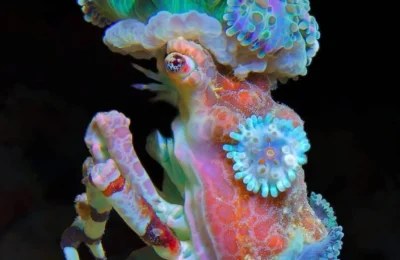The Paper:
Candia-Zulbarán, Rebeca I., et al. Caribbean spiny lobsters equally avoid dead and clinically PaV1-infected conspecifics. ICES Journal of Marine Science: Journal du Conseil (2015): doi: 10.1093/icesjms/fsu249
Background:
The Caribbean spiny lobster, Panulirus argus, is more than just a tasty crustacean (Fig. 1). In order to survive on the rocky seafloor, spiny lobsters need to efficiently communicate, detect predatory threats, and find potential prey. In the absence of strong vision or sound, these processes are accomplished through a developed sensory mechanism known as chemoreception. This sensory system allows spiny lobsters to survey (“sniff out”) the surrounding water, uptake and process chemical cues (scents), and react appropriately. Spiny lobsters can be very social with conspecifics (members of the same species) and form large colonies underneath rocks and corals. Basic communication is transmitted through released urine from conspecifics, which help individual lobsters find shelter. Blood-borne cues from deceased spiny lobsters alert conspecifics of nearby predation. Eels, nurse sharks, skates, and other large fish are known to prey upon the Caribbean spiny lobster.

The Caribbean spiny lobster population has steadily declined over the last two decades. The main cause for this drop is the P. argus virus 1 (PaV1), which targets juvenile spiny lobsters. This disease is transmitted to other lobsters through water and several weeks can pass before symptoms show up. Infection weakens mobility of spiny lobsters and leads to eventual decomposition of internal organs. So, why hasn’t this disease completely erased the spiny lobster population? Well, thanks to their incredible sensory system, spiny lobsters can avoid visibly infected conspecifics. It remains to be seen if spiny lobsters can detect conspecifics who appear healthy but have contracted PaV1. The aim of this study was to better understand the responses of healthy, uninfected spiny lobsters to lobsters infected at different stages of PaV1.
Methods:

Healthy and visibly diseased juvenile Caribbean spiny lobsters were collected off the coast of Mexico. Noticeably infected lobsters were classified based on a milky-white substance inside their abdomen (Early stages of organ failure). Molecular techniques were used to test for the presence of PaV1 in healthy-looking lobsters. The experimental setup consisted of a 2 meter length maze with two independent head tanks (Fig. 2). A panel divided half of the maze, which allowed healthy lobsters to choose between two different shelters near the far end. Seawater was pumped into each head tank separately and flowed through the corresponding shelter to transport scents into the maze (Think of it as a simulated water current). Chemical scents originated from lobsters kept in one side of the tank. Depending on treatment, lobsters were either uninfected, subclinically infected (PaV1 positive, but appear healthy), clinically infected, or deceased. In all experiments, the other head tank contained a 100% seawater control (Meaning no lobster or chemical scent). “Attraction” occurred if the healthy lobster chose the shelter with a chemical stimulus and “avoidance” if the lobster chose the seawater control shelter.
Results:

Healthy spiny lobsters were attracted to shelters with chemical cues from other uninfected conspecifics (63% attraction) and had a somewhat low percentage of avoidance (45%) in the presence of subclinically infected conspecifics (Fig. 3). In other words, healthy spiny lobsters could not properly identify conspecifics who were healthy but still PaV1 positive. In contrast, healthy spiny lobsters clearly avoided shelters that produced chemical cues from clinically PaV1-infected (80% avoidance) and dead conspecifics (85% avoidance).
Conclusion and Significance:
Healthy spiny lobsters were willing to join shelters with scents from uninfected conspecifics, which was not surprising. In the wild, urine-borne cues are known to attract healthy spiny lobsters to shelters with other healthy individuals (How thoughtful!). Healthy spiny lobsters avoided chemical cues from either clinically PaV1-infected or dead conspecifics. Similar to a detective, a healthy spiny lobster can “sniff out” these harmful scents and avoid contact with dead or diseased individuals. Dead lobsters are known to produce blood-related cues that warn healthy lobsters of predation (Again, how thoughtful!). The origin of the PaV1 chemical is not as clear. Are healthy spiny lobsters repelled by chemicals that come from the pathogen or the infected host itself? It is proposed that diseased lobsters may give off “necromones”, which are chemicals that turn healthy lobsters away from the immediate area.
The picture becomes blurry when considering newly PaV1-infected spiny lobsters that do not show signs of decay. In this study, healthy spiny lobsters did not significantly avoid functional lobsters with the PaV1. Spiny lobsters that are in the early stages of infection may release “repulsive” chemical cues at small levels or not at all. Healthy spiny lobsters cannot recognize infected individuals early in the PaV1 stages, which does not bode well for survival rates. PaV1 is already a major issue within the Caribbean spiny lobster community and accounts for the largest amount of mortality of this species. How localized is this PaV1 pathogen? Is there a way to minimize its impact on the spiny lobster population? Are there other pathogens related to PaV1 that target other crustaceans? How may this hurt predators who rely on spiny lobster? Future work will need to consider these questions and attempt to further understand the PaV1 pathogen and how it may continue to impact Caribbean spiny lobsters.
I am a first year MS candidate at the University of Rhode Island, Graduate School of Oceanography. I am interested in plankton ecology and the dynamics within plankton food webs. My research interests include the behavioral and physiological responses of phytoplankton and heterotrophic predators.

